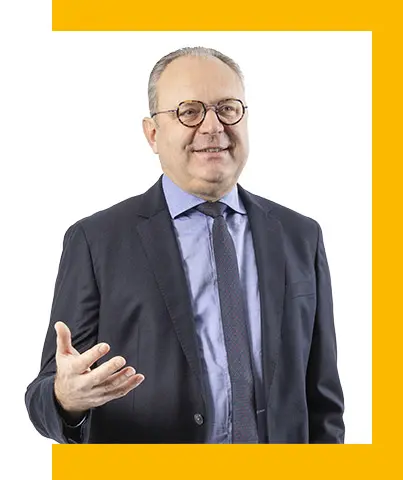Introduction by Johan Vandermeulen
“Regulators’ acceptance of Tobacco Harm Reduction is essential to enable adult consumers who otherwise would continue to smoke to switch completely to Smokeless Products.”
Johan Vandermeulen
Chief Operating Officer

BAT’s strategic aim is to actively migrate adult smokers who would otherwise continue to smoke to Smokeless Products that present a reduced risk*† compared to combustible cigarettes. We sat down with our chief operating officer, Johan Vandermeulen, to talk about his embrace of Tobacco Harm Reduction and his role in leading change to Build a Smokeless World.
1. How are you seeing THR being manifested in BAT’s markets across the globe?
There are examples all over the world of how Tobacco Harm Reduction and adoption of Smokeless Products have and are expected to further impact smoking rates and disease incidence. The case in Sweden is a fantastic example. Additionally, extrapolating from that Swedish data through population modelling, researchers have suggested that had other EU Member States had the same rate of tobacco attributed mortality as Sweden, potentially 2.9 million premature deaths could have been averted over a 20-year period.[1]
As I travel to our various markets around the globe, I think of how those policies could impact lives in those countries, like Mexico, Brazil—all of those adult smokers who otherwise would continue to smoke could be given access to legal Smokeless Products as options to move down the risk continuum in these and other countries.
Smokeless Products have accelerated THR progress in regions with diverse regulatory, cultural, and market landscapes. When access to Smokeless Products is expanded, so too will be the opportunity to deliver even larger THR outcomes.
2. As COO, how do you balance financial performance with the need to invest in a sustainable future?
We are on a transformation journey. It is not solely driven by financial decisions; these investments depend on where we legally are allowed to offer Smokeless Products. Ultimately, we want smokers who would otherwise choose to continue to smoke to switch completely to Smokeless Products. For example, I would love to be able to introduce vapour, modern oral, and heated tobacco products in Brazil, but factored into that equation is, of course, regulation and where these products can be made available. Relatedly, we must continue to responsibly manage our transition away from combustibles, generating funds to further invest in our transformation. If tomorrow some of these markets were to open up in terms of an appropriate regulatory and excise framework, we would be ready to go.
3. Can you talk a bit about BAT’s investment in science, research, and development for Smokeless Products?
I think we can always do more. I think it’s also a matter of how we leverage new innovations, such as predictive modelling and other new technologies that can optimise our research, making it more effective and more efficient. We also should be inquisitive and open-minded in considering what we can be doing differently. We don’t have to do everything ourselves; we should explore how we can collaborate with third parties to tap into innovation and the latest evolutions. And that's where we should focus on breakthrough innovation. This is the way to take our products to the next level and advance THR.
“As an engineer with an affinity for science, I believe in fact-based evidence. Because of that, I have a strong, passionate belief in Tobacco Harm Reduction.”
Johan Vandermeulen
Chief Operating Officer
4. What are the challenges BAT faces as we scale up our smokeless alternatives globally?
Of course, there always are logistical challenges associated with scaling up, but one of the biggest barriers is a lack of proportionate regulation that differentiates Smokeless Products from combustible products in a way that encourages smokers who would otherwise continue to smoke to switch completely.
BAT and its business partners have a key role in maximising the potential of Smokeless Products, but we can’t do it alone. There is responsibility on the part of policymakers to look objectively at the science and data supporting THR and to ensure that their policies and regulations reflect the facts. We recognise and support the role of regulation in achieving reduced smoking rates and minimising health impacts. But to achieve THR, Smokeless Products must be supported by progressive regulation and excise regimes that are based on scientific evidence and effectively deliver the intended policy goals while avoiding unintended consequences like illicit trade.
As I’ve said, there is evidence from public sources in various countries around the world such as Sweden, New Zealand, and the UK that supports the proposition that smoking prevalence decreases at faster rates when adult smokers have access to a wide range of smokeless alternatives to cigarettes.
5. Do you think BAT can make a sustainable business from Smokeless Products?
I know we can. I think sometimes we undervalue what we have done so far. I have been with BAT for 32 years, and we’ve been innovating throughout that period, but advances in technology in the past decade have fuelled our ability to evolve and transform.
We must remain focused on our ambition to achieve 50 million adult consumers# of our Smokeless Products by 2030, and we want at least 50% of our revenue to come from Smokeless Products by 2035. The North Star is focusing on how to achieve that strategic ambition, to determine what are the enablers, and we're making very good progress there.
A key enabler is our continued advocacy for Tobacco Harm Reduction to be embedded in regulatory frameworks around the world. THR should not be seen as only for developed countries or the developed world. The introduction of progressive, sustainable regulation everywhere the BAT Group sells cigarettes would enable adult smokers who otherwise would continue to smoke to access a wide range of smokeless alternatives to cigarettes.
I believe we were correct in saying that the right approach to Tobacco Harm Reduction includes different options and different choices, as there is no one-size-fits-all product that will appeal to adult smokers who otherwise would continue to smoke. In terms of strategic thinking, that of course puts constraints and stress on resources. But we understand that THR is the right thing to do.
We want to be the undisputed leader, ultimately, in terms of this transformation and migration to Smokeless Products. And we know we’ve made the right decisions, as Smokeless Products now account for 17.5% of Group revenue, and that number will continue to grow.
It’s a very compelling story, and an enormous opportunity. That is why I am so passionate about it.
6. What are you most excited about for the coming year in terms of how BAT brings Smokeless Products to market?
We have a lot of breakthrough innovations coming in across all three categories of Smokeless Products that will enter the market this year, which for me is the most exciting thing. The innovation cycle, and in particular the time to get new products and innovations to market, is shortening in many countries, which is good for the company and for consumers alike. And we are well placed to lead in these categories.
At the same time, I have two big concerns: first, that some of that forward progress has been slowed by regressive changes in regulation in some markets, such as Mexico. My second concern is related to the lack of enforcement leading to a massive growth of illicit trade with questionable products flooding the market, as in Australia.
Policymakers have to acknowledge that appropriate and proportionate regulation is necessary: there must be a proper framework in place. They also must acknowledge the need to stimulate innovation; stopping innovation is never a good strategy, and adult smokers should have access to these innovations. There is a massive opportunity for THR to have a positive impact in the future.
“We can’t do it alone. There is massive responsibility on the part of policymakers to look objectively at the science and data supporting THR and to ensure that their policies and regulations reflect the facts.”
Johan Vandermeulen
Chief Operating Officer
7. What would you say to critics who characterise BAT’s efforts to Build a Smokeless World as just another way to keep selling cigarettes?
I would tell them to look at the numbers—our investments in Smokeless Products, the accelerated declines in smoking rates in countries across the globe, the number of Smokeless Product consumers who are former smokers.[2] We are actively encouraging adult smokers who would otherwise continue to smoke to switch completely to smokeless alternatives.
While some scepticism is to be expected, I think one of the issues with certain government bodies and public health organisations is that they don't understand the products at all. They haven't actually talked to the consumers that use them. That perspective is of crucial importance.
As an engineer with an affinity for science, I believe in fact-based evidence. Because of that, I have a strong, passionate belief in Tobacco Harm Reduction. Governments, policymakers, and the public health community have a shared responsibility to educate adult consumers and broader society. Regulators’ acceptance of Tobacco Harm Reduction is essential to enable adult consumers who otherwise would continue to smoke to switch completely to Smokeless Products. Displacing combustibles will require policymakers to take the step of translating the science of toxicants, emissions, and product risk into something accessible and understandable, and to align policies and regulations with the science and data supporting THR.
BAT has the drive to keep on innovating and moving the needle. The biggest breakthrough has happened with the introduction of Smokeless Products; from here, we all need to take it to the next level to transform to A Smokeless World.
Footnotes
* Based on the weight of evidence and assuming a complete switch from cigarette smoking. These products are not risk free and are addictive.
† Our products as sold in the U.S., including Vuse, Velo, Grizzly, Kodiak, and Camel Snus, are subject to FDA regulation and no reduced-risk claims will be made as to these products without agency clearance.
# The number of consumers of Smokeless Products is defined as the estimated number of Legal Age (minimum 18 years) consumers of the Group’s Smokeless products - which does not necessarily mean these consumers are solus consumers of these products. In markets where regular consumer tracking is in place, this estimate is obtained from adult consumer tracking studies conducted by third parties (including Kantar). In markets where regular consumer tracking is not in place, the number of consumers of Smokeless Products is derived from volume sales of consumables and devices in such markets, using consumption patterns obtained from other similar markets with adult consumer tracking (utilising studies conducted by third parties, including Kantar).
References
[1] Human D., et al, Saving Lives Like Sweden. Smoke Free Sweden, 2023. (Assessed 14 March 2025)
[2] See, e.g., Action on Smoking and Health (ASH), Use of e-cigarettes (vapes) among adults in Great Britain. 2024. (Assessed 14 March 2025)
Sign up for more exclusive the Omni™ content
-
 Smokeless Products: An Introduction
Smokeless Products: An Introduction -
 01. Our Vision: A Need for Reappraisal
01. Our Vision: A Need for Reappraisal -
 02. The Big Questions
02. The Big Questions -
 03. Impact of Smoking
03. Impact of Smoking -
 04. Our Smokeless Science
04. Our Smokeless Science -
 05. Our Smokeless Products
05. Our Smokeless Products -
 06. THR: A Global Transformation
06. THR: A Global Transformation -
 07. THR: Global Regulation
07. THR: Global Regulation -
 08. THR: Scientific Engagement
08. THR: Scientific Engagement -
 09. Our Future Outlook
09. Our Future Outlook -
 10. References
10. References -
 11. Our Published THR Science
11. Our Published THR Science
